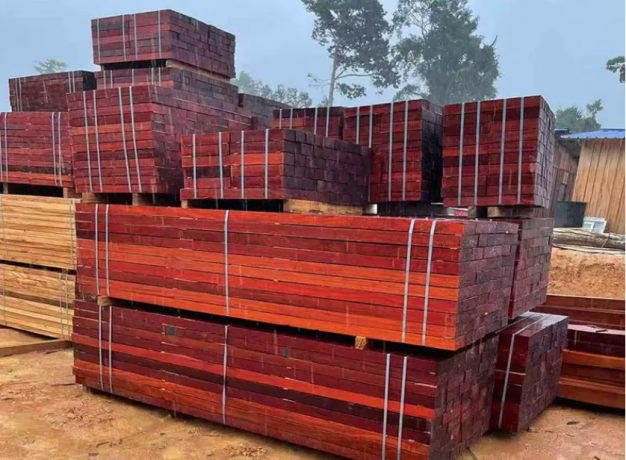please click here:
https://www.shdtimber.com/products.html
Padouk wood is one of the most striking and versatile exotic hardwoods available today. Known for its intense red to orange hues and long-lasting durability, Padouk has become a favorite among woodworkers, furniture designers, and musical instrument makers. Its combination of aesthetic appeal and functional performance makes it a unique choice for both practical and decorative applications. In this comprehensive guide, we will explore Padouk wood's origins, properties, uses, care, and comparisons with other exotic woods to help you make informed decisions for your woodworking projects.
Origins and Species of Padouk Wood
Padouk is derived from several species within the Pterocarpus genus, primarily found in tropical regions. The main types include:
-
African Padouk (Pterocarpus soyauxii): Native to Central and West Africa, this species is prized for its vibrant red heartwood that gradually darkens to brown over time. It is widely used in furniture and flooring due to its stability and durability.
-
Burmese Padouk (Pterocarpus macrocarpus): Found in Southeast Asia, particularly Myanmar, this variety has yellowish to reddish-brown heartwood that matures to a golden hue. It is often used in cabinetry and decorative objects.
-
Andaman Padouk (Pterocarpus dalbergioides): Found in the Andaman Islands, India, this wood is deep reddish-brown and highly durable. It is commonly used in high-end furniture and intricate woodcraft.
These varieties share similar workability characteristics and aesthetic appeal, but their subtle differences in color, grain, and density make them suitable for different applications.
Physical Properties of Padouk Wood
Padouk wood is known for its impressive physical characteristics:
-
Density and Hardness: African Padouk has an average density of around 745 kg/m³ and a Janka hardness ranging from 1,710 to 1,970 lbf. This makes it stronger and harder than many common domestic hardwoods, while still being workable.
-
Grain and Texture: Padouk often has a straight grain, but interlocked grain can occur. Its texture is fine to medium, giving a smooth and even finish when sanded.
-
Stability: Padouk exhibits excellent dimensional stability, resisting warping, shrinking, and swelling. This property makes it ideal for precision woodworking and high-quality furniture.
-
Workability: Despite its hardness, Padouk is easy to machine and shape. It sands smoothly and takes finishes well. However, planing or cutting interlocked grain can cause minor tear-out if not handled carefully.
Color and Aesthetic Characteristics
One of Padouk's most attractive features is its color:
-
Freshly Cut Wood: Newly sawn Padouk displays bright red to orange tones that stand out immediately. This vibrant color is often used to make statement pieces in furniture, flooring, and decorative objects.
-
Aging Process: Exposure to air and light gradually darkens Padouk to a deep reddish-brown, adding a warm and natural richness. Over time, its vibrant hues mellow into more sophisticated tones, which many woodworkers consider highly desirable.
-
Figure and Grain Patterns: Padouk can show subtle figure patterns such as interlocked grain or fine streaks, adding depth and character to surfaces. These patterns are particularly appreciated in veneers and decorative inlays.
Common Applications of Padouk Wood
Padouk's combination of beauty and durability allows for diverse applications:
-
Furniture: Its hardness and stability make Padouk ideal for chairs, tables, cabinets, and other furniture pieces. Its striking colors also serve as a visual highlight in living spaces.
-
Flooring and Decking: Padouk's natural resistance to wear and decay makes it suitable for both indoor and outdoor flooring. Its vibrant red hues give floors a unique and luxurious look.
-
Musical Instruments: The wood is favored in xylophones, marimbas, drums, and guitars due to its tonal quality and strength.
-
Turned Objects and Inlays: Small decorative items such as knife handles, pens, bowls, and inlays benefit from Padouk's ease of machining and beautiful coloration.
-
Veneers and Panels: Thin slices of Padouk are used for veneering, offering the appearance of solid exotic wood without the cost of full planks.
Durability and Resistance
Padouk is naturally durable and resistant to environmental threats:
-
Decay Resistance: It is highly resistant to fungi and rot, making it suitable for outdoor and damp environments.
-
Insect Resistance: Padouk has natural properties that deter termites and other wood-boring insects.
-
Longevity: Furniture and flooring made from Padouk can last decades when properly maintained, often outlasting domestic hardwoods like oak and maple.
-
Sustainability Considerations: Responsible sourcing is important, as overharvesting could affect availability. Sustainable forestry practices ensure Padouk remains a reliable material.
Care and Maintenance of Padouk Wood
Maintaining Padouk wood ensures it retains its beauty for decades:
-
Cleaning: Dust regularly with a soft cloth. Avoid harsh chemicals that can damage the surface.
-
Finishing: Apply oils, waxes, or polyurethane finishes to protect the wood and enhance its natural color. UV-resistant finishes can help preserve its vibrant red hue longer.
-
Sunlight Exposure: Prolonged exposure to direct sunlight accelerates color changes. Using window treatments or placing items away from direct sun can maintain initial vibrancy.
-
Handling: Wear protective gloves when sanding or finishing. Wood dust can cause mild skin irritation for sensitive individuals.
Comparison With Other Exotic Hardwoods
Here's a detailed comparison of Padouk with two other popular exotic woods:
| Property | Padouk | Bloodwood | Walnut |
|---|---|---|---|
| Color | Bright red to orange | Deep red | Dark brown |
| Janka Hardness | 1,710–1,970 lbf | 2,590 lbf | 1,010 lbf |
| Grain Workability | Easy to moderate | Challenging | Moderate |
| Durability | High | Very high | Moderate |
| Cost | Moderate | High | High |
Analysis: Padouk offers a unique balance of vibrant color, workability, and durability. While not as dense as Bloodwood, it is more visually striking and easier to machine. Walnut, on the other hand, is classic and elegant but lacks the vivid red tones that make Padouk stand out.
Tips for Using Padouk in Projects
-
Accent Pieces: Use Padouk as a highlight wood in furniture to showcase its color without overwhelming the design.
-
Blending with Other Woods: Combine Padouk with neutral tones like maple or ash to create visually appealing contrasts.
-
Finishing Techniques: Experiment with natural oils and clear finishes to deepen the color or enhance its natural shine.
-
Preventing Cracks: Allow the wood to acclimate to indoor humidity before cutting or assembling to reduce the risk of splitting.
-
Storage: Store raw Padouk in a dry, ventilated area to prevent mold or distortion.
Frequently Asked Questions About Padouk Wood
1. Where is Padouk wood primarily sourced from?
Padouk comes from tropical regions in Africa, Southeast Asia, and India. African Padouk is widely available and most commonly used for woodworking projects.
2. How does Padouk color change over time?
Freshly cut Padouk is bright red-orange, which gradually darkens to reddish-brown with exposure to air and light.
3. Can Padouk be used outdoors?
Yes. Its natural decay and insect resistance make it suitable for outdoor furniture, decking, and decorative structures.
4. Is Padouk good for musical instruments?
Absolutely. Its tonal qualities make it ideal for xylophones, marimbas, drum shells, and even guitar components.
5. How should I maintain Padouk furniture?
Dust regularly, apply protective finishes, minimize prolonged sun exposure, and handle carefully during sanding or polishing to maintain color and surface integrity.
6. How does Padouk compare to other red hardwoods?
Padouk is less dense than Bloodwood, making it easier to work, while offering more vibrant color than Walnut. Its combination of aesthetics and workability is a key advantage.
7. Is Padouk environmentally sustainable?
Responsible sourcing and adherence to sustainable forestry practices ensure Padouk's availability. Overharvesting can be mitigated through proper certifications.
Article Summary
Padouk wood is a tropical hardwood valued for its vibrant red hues, durability, and versatility. Suitable for furniture, flooring, musical instruments, and decorative items, it combines beauty with functionality. Proper care preserves its color and longevity, making it a prized choice for woodworkers and designers seeking an exotic, high-quality material.






